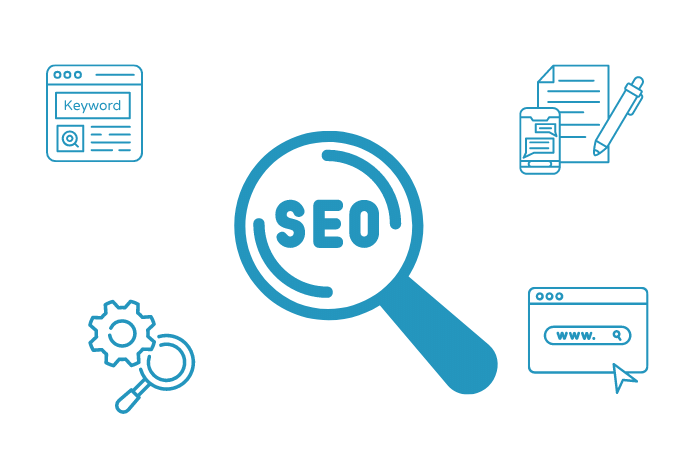Table of Contents
- Introduction: Defining SEO and its importance for websites
- Understanding the basic elements of an SEO-friendly website
- Choosing the right keywords for your website
- Optimizing content for SEO
- Optimizing images and videos for SEO
- Optimizing URL structures for SEO
- Conclusion: Summarizing the key points and benefits of SEO for websites
Introduction: Defining SEO and its importance for websites
Search Engine Optimization (SEO) is the process of optimizing a website or web page in order to improve its visibility and ranking in search engine results pages (SERPs). SEO is a critical part of any digital marketing strategy, and it is essential for any website to be found and accessed by potential customers. SEO involves a variety of techniques, including keyword research, content optimization, link building, and more, that help to improve the visibility of a website in search engine results.
By utilizing SEO techniques, companies can increase the number of visitors to their website, which in turn can lead to increased sales and conversions. SEO focuses on creating high-quality content that is keyword-rich and optimized for the target audience. Content should be informative, helpful, and engaging to ensure that people are more likely to stay on the website for longer and convert into customers. Additionally, SEO also involves optimizing the technical aspects of a website, such as improving page speed, making sure the website is mobile-friendly, and other technical elements.
By utilizing SEO techniques, companies can increase the visibility and ranking of their websites and improve their chances of being found and accessed by potential customers. SEO is a critical part of any digital marketing strategy, and it is essential for any website to be found and accessed by potential customers. SEO should be implemented as part of any digital marketing strategy in order to maximize the success of a website and achieve the desired goals.
Looking for an SEO Agency to take care of your website? Visit SEO Services.
Understanding the basic elements of an SEO-friendly website

Having an SEO-friendly website is key to driving traffic to your site and increasing your online visibility. Although there are many elements that go into making a website SEO-friendly, understanding the basics is a great starting point.
The first step in creating an SEO-friendly website is to make sure that your website is properly structured. This means making sure that all the pages have titles and meta descriptions, and that your URLs are easy to read and understand. You should also make sure that your website is optimized for speed, as slow loading websites are penalized by search engines. Additionally, you should use keywords and phrases throughout your website, as well as using appropriate headers, alt tags, and internal links.
When it comes to content, it’s important to create content that is relevant to your business and that is valuable to your target audience. This includes producing useful, entertaining content using appropriate keywords and phrases. Additionally, you should make sure that your content is original and unique, as duplicate content can hurt your SEO efforts.
By understanding the basic elements of an SEO-friendly website, you can take your online presence to the next level and ensure that your website is seen by more people. With the right SEO techniques, you can make sure that your website is ranking higher in search engine results, and that you’re getting the most out of your website.
Choosing the right keywords for your website
Choosing the right keywords for your website can be a daunting task. There are so many different options out there and it’s hard to know which ones to focus on. But, it’s essential to get this right if you want to rank well in search engine results. To get started, think about the words a potential customer might use to search for your products or services. These are the words you’ll want to focus on. You can also use keyword tools to help you identify the most popular and relevant keywords for your website. These tools can provide helpful data on search volume, competition, and related keywords. Just remember to keep your keywords specific and relevant to what you’re offering. Broad and generic keywords won’t help you stand out from the competition.
You should also aim to use keywords throughout your website, not just in the content. This includes your URL, title tags, meta descriptions, and more. Doing so will help search engines understand what your website is about and boost your rankings. All in all, taking the time to research and select the right keywords for your website will pay off in the long run.
Optimizing content for SEO
Optimizing content for SEO friendly websites is a great way to make sure your website is seen in search engine results, and to get more visitors to your website. It’s not always an easy task, but with some tips and tricks, you can make sure your content is as optimized as possible.
First, make sure your content is relevant to the topic of your website. Search engines are more likely to rank content that is related to what people are searching for. You should also make sure your content is well written, informative, and interesting. This will help keep visitors on your website longer and make them more likely to click on other pages.
Optimizing images and videos for SEO

Optimizing images and videos for SEO friendly websites is an important part of creating an effective website. Not only does it help search engines understand what your site is about, but it can also drastically improve the user experience. This is because people are more likely to stay on a site that has optimized images and videos, as well as one that loads quickly. By optimizing your images and videos, you can make sure that your website stands out from the competition and that visitors are able to find the information they are looking for quickly and easily.
When optimizing images and videos for SEO, you need to make sure that you have properly sized images and videos, as well as properly tagged files. This means that you need to make sure that the images and videos are the correct size and that they are tagged with the appropriate keywords. This can help ensure that the search engine can easily find and index your content. Additionally, you should also ensure that the images and videos are compressed in order to reduce the file size and make them load faster.
Optimizing URL structures for SEO
You should make sure your URLs are well-structured and easy to read, as this will help the search engine bots to easily crawl and index your web pages. Your URLs should also include relevant keywords, as this will help to improve your website’s ranking for those keywords. Additionally, make sure your URLs are short and straightforward, as long and complex URLs can be difficult for search engine bots to understand. Additionally, you should also use hyphens or underscores to separate words in your URLs, as this can help search engines to better understand the content of your webpages.
Conclusion: Summarizing the key points and benefits of SEO for websites
By following the tips outlined in this article, you should be well on your way to making your website SEO friendly. It takes time and effort to make sure your website is optimized for the best possible search engine results, but the effort is worth it. With the right keywords, content, and other techniques, you can increase your visibility in the online world. Good luck and happy optimizing!

